Looking & Seeing
one long look at one work of art
John O'Hern is an arts writer, curator and retired museum director who is providing a weekly contemplation of a single work of art from our gallery. In our fast-paced lives overflowing with information, we find it necessary and satisfying to slow down and take time to look. We hope you enjoy this perspective from John.
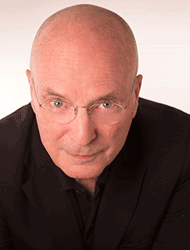
John O'Hern has been a writer for the 5 magazines of International Artist Publishing for nearly 20 years. He retired from a 35-year-long career in museum management and curation which began at the Albright-Knox Art Gallery where he was in charge of publications and public relations and concluded at the Arnot Art Museum where he was executive director and curator. At the Arnot Art Museum he curated the groundbreaking biennial exhibitions Re-presenting Representation. John was chair of the Visual Artists Panel of the New York State Council on the Arts and has written essays for international galleries and museums.
December 29, 2024
HARRIET YALE RUSSELL | Sintra
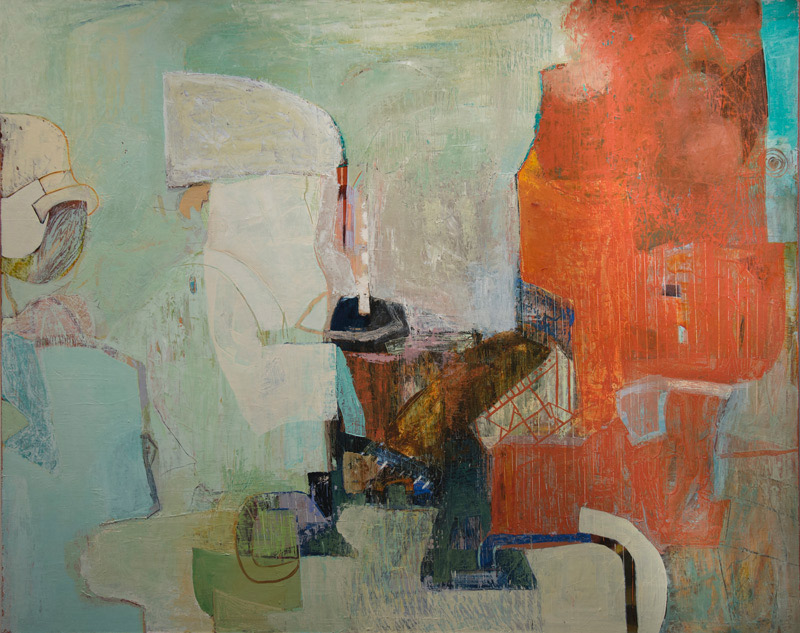
Harriet Yale Russell (1939-2023) received her MFA in Painting in 1994 from the San Francisco Art Institute where Richard Diebenkorn (1922-1993) had been a student and an instructor. Diebenkorn was one of her artist influences throughout her career.
He once said, “Do search, but in order to find other than what is searched for.” Since I never met Russell I’ve learned about her through the writing of others who knew her and by looking more closely at her art. Doing some research on my own, however, I found “other than what is searched for” (otherwise known as going down a rabbit hole).
Russell was born in Rochester, NY. Her mother was a painter and her father was a chemist with Eastman Kodak Company. One of the interesting rabbit hole tidbits is an article in the December 27, 1957 “Democrat and Chronicle” in Rochester titled “Debutantes’ Night: 13 Introduced to Society at Annual Symphony Ball”. Among the young women was 18-year-old Harriet Yale Russell who “wore peau de soie with a flowing skirt fastened at the back with two pink roses”. Her Yale ancestry goes back to the early settlers of New Haven, CT. Yale College was founded in 1701 and named after an early benefactor, Elihu Yale.
She attended the School of the Museum of Fine Arts, Boston, where she received her degree “with distinction” in the Department of Graphic Arts. She taught etching at the school for 10 years and in 1969 received it’s Clarissa Bartlett Traveling Scholarship for a year of travel in Portugal.
Among her paintings at Evoke is Sintra, recalling the picturesque resort town of Sintra, near Lisbon.
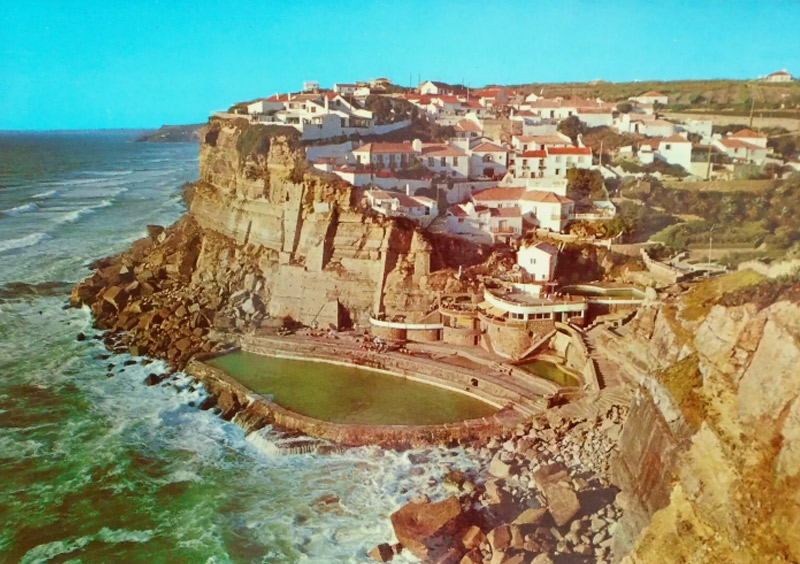 In her essay in the January 2023 issue of “Evokation”, Mara Christian Harris recalls Post-it notes in Russell’s studio, one of which contained the phrase “Listen to the paint.” The phrase recalls Diebenkorn who wrote, “I don't go into the studio with the idea of 'saying' something. What I do is face the blank canvas and put a few arbitrary marks on it that start me on some sort of dialogue.”
In her essay in the January 2023 issue of “Evokation”, Mara Christian Harris recalls Post-it notes in Russell’s studio, one of which contained the phrase “Listen to the paint.” The phrase recalls Diebenkorn who wrote, “I don't go into the studio with the idea of 'saying' something. What I do is face the blank canvas and put a few arbitrary marks on it that start me on some sort of dialogue.”
In her essay, Elizabeth L. Delaney writes, “Russell maintains hands-on contact with her medium at every stage of the creative process, even making her own paint. When it’s time to work, she often begins painting directly on the canvas without any preliminary work. This approach preserves a sense of spontaneity, while also allowing the artist to explore her vision freely—or be led by the paint as she applies it. ‘You either tell the painting where it’s going, or it tells you,’ she says….
“Russell embraces the essential, timeless qualities of total abstraction contained within the formal elements from which she derives visual matter, even as she infuses her paintings with the deep, internal feeling that propelled her to pick up a paintbrush in the first place.”
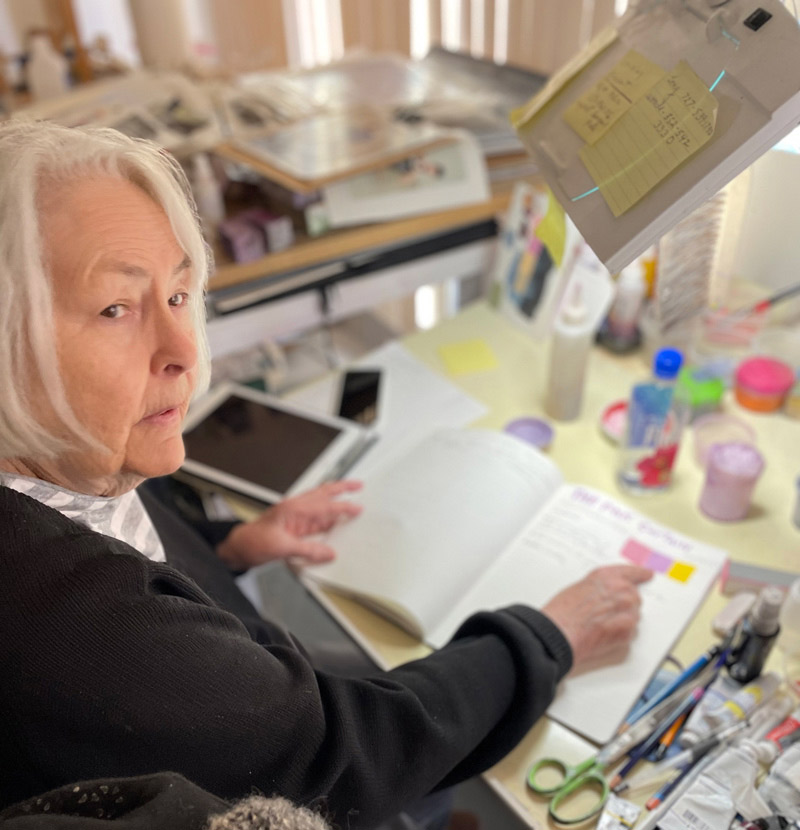 As a vociferous advocate of contemporary representational art since the early 90s I curated 3 exhibitions of figurative art here at Evoke. One of the many great things about the gallery, however, is its mix of representation and abstraction.
As a vociferous advocate of contemporary representational art since the early 90s I curated 3 exhibitions of figurative art here at Evoke. One of the many great things about the gallery, however, is its mix of representation and abstraction.
Diebenkorn wrote, “All paintings start out of a mood, out of a relationship with things or people, out of a complete visual impression. To call this expression abstract seems to me often to confuse the issue. Abstract means literally to draw from or separate. In this sense every artist is abstract . . . a realistic or non-objective approach makes no difference. The result is what counts.”
My first museum job was from 1973 to 1976 at the then Albright-Knox Art Gallery (now the Buffalo AKG Art Museum). One of the experiences of that time was working with some of the great non-objective artists of the period, one of whom was Richard Diebenkorn. In 1976 we produced the exhibition Richard Diebenkorn: Paintings and Drawings, 1943-1976 which traveled across the country. Diebenkorn and I worked on the catalogue and one of my great treasures is my copy inscribed “For John—with great respect, Dick”.
His wife, Phyllis, recalled the exhibition. “It was major . . . this one sort of made Dick national. He was pretty well-known in the art world, but this . . . did it.” It’s hard to think of Diebenkorn being other than internationally renowned with one of his Ocean Park recently selling for more than $1 million.
It’s also hard to think of Russell and her work not being more well-known. Evoke’s exhibitions have brought well-deserved attention to yet another female abstract painter overshadowed in a male-dominated art world. She moved to New Mexico in 1997 and we can think of her as our own, still deserving of wider attention.
Mara Christian Harris writes that Russell “attended a progressive school whose motto was ‘To thine own self be true,’ a maxim to which she has tried to remain true throughout her life . . . Russell revels in the freedoms of abstraction, even on a smaller scale. ‘Your only restriction is yourself,’ she says. While her subjects are serious, Russell enjoys playing with graphic elements and media—in person, her very present sense of humor is a contrast with the solemnity of her themes. Her work is smaller and darker than before, yet more playful. ‘I’m much more focused than ever before—I’m doing something very personal.’
Elizabeth Delaney writes, “Russell revels in the mystery and adventure of art making. Accepting the fact that she never quite knows where any one piece will take her, Russell finds the process of discovery to be the motivating force behind her work—its raison d’ệtre. ‘I think it’s the wonder of it, that you don’t know what you’re doing,’ she says. Her thrill lies in continually searching for the right shape or color or combination thereof, and then in the momentary satisfaction as they coalesce in a visually and emotionally engaging manner . . .
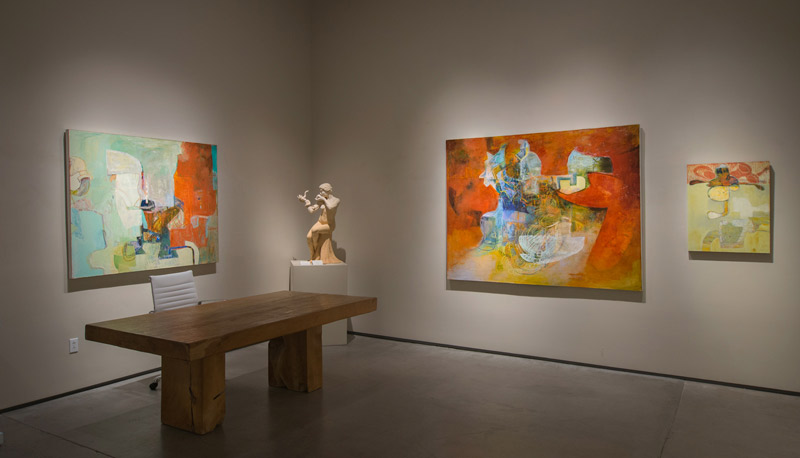 “'Life goes on, and certain things stick out and inspire you,’ says Russell. Frequently garnering subject matter from an ongoing narrative in her head—both waking thoughts and dreams—she also responds to her surroundings. Her work, in turn, becomes the physical representation of what she sees or experiences or wonders. It contains unique, nonrepresentational subject matter, which is at once personal to her and universal to viewers. Likewise, Russell’s paintings are informed by her strong sense of design, rooted in traditional aesthetic principles.
“'Life goes on, and certain things stick out and inspire you,’ says Russell. Frequently garnering subject matter from an ongoing narrative in her head—both waking thoughts and dreams—she also responds to her surroundings. Her work, in turn, becomes the physical representation of what she sees or experiences or wonders. It contains unique, nonrepresentational subject matter, which is at once personal to her and universal to viewers. Likewise, Russell’s paintings are informed by her strong sense of design, rooted in traditional aesthetic principles.
“Russell has always painted in a nonrepresentational style that both examines and celebrates relationships between formal elements on the X, Y, and Z axes. Shapes emerge and recede, collide and disengage, not simply across a singular surface, but among the many levels assembled, disassembled, and ultimately revealed within the picture plane. As such, she creates a micro-universe of infinite possibilities.”
Russell’s paintings recall Diebenkorn’s, their mark making a record of their being laid down, covered, revealed and coalescing into a coherent whole. She said, “I’ve worked my whole life to find my own marks; the marks that are mine and mine alone.”
The dark central form of Sintra anchors her composition and is surrounded by abstractions of layers of color that invite exploration and contemplation.

